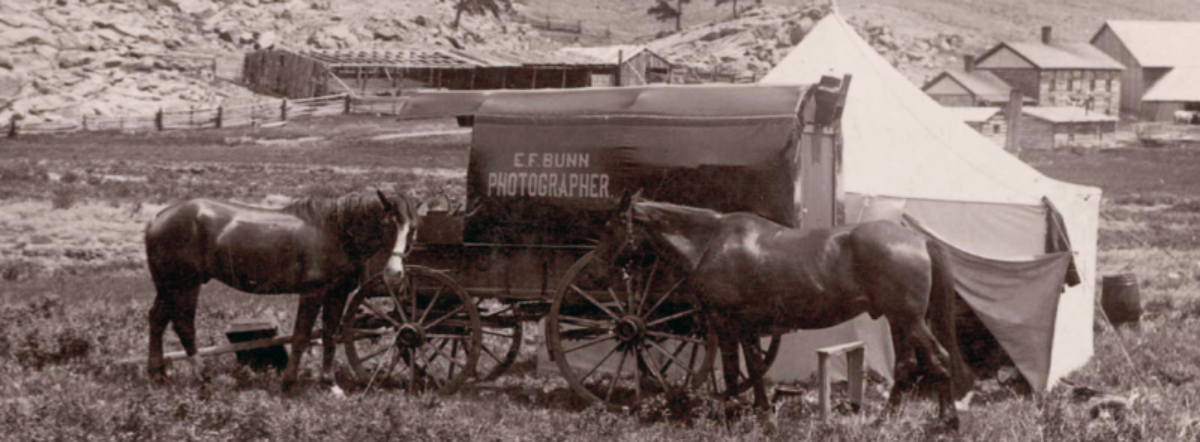This post identifies studio photographers active in Greeley in the 1890s. See my earlier posts for photographers working in the 1870s, early 1880s, and late 1880s. Did I miss any photographers? Can you provide any additional biographical details?
1890
Harry G. Townend (1862-1928) was born in Ohio to British immigrants Henry Townend and Christiana Garthwaite Townend. By 1870, the Townend family lived in western Massachusetts. In 1884, H. G. Townend began his professional career as a Fitchburg (MA) National bank teller. Townend resigned from the bank in 1889 and moved to Greeley, Colorado to improve his health. A mount credited to Townend features a portrait of Greeley high school class of 1890, one of his only extant photographs. Townend and his wife, Susan Amelia Upton Townend, returned to Massachusetts in June 1890. He resumed his banking career, ultimately becoming a bank president. Townend died on December 24, 1928, after a long illness. His remains rest in Fitchburg’s Forest Hill Cemetery.

Frank Knapp (1862-1894) Born in in Tompkins County, New York, Knapp learned photography in Ithaca, New York with William Frear. After a brief time working in a New York City gallery, Knapp took a position at J. W. Taylor’s studio in Rochester. In 1889, he opened his own business at 138 East Main Street. His business struggled and Knapp pursued a photography position with John C. H. Grabill in South Dakota.
Grabill advanced travel expenses to Knapp, but he never arrived. Instead, Knapp spent a couple of months working for M. E. Chase in Greeley. When it became known that Knapp had failed to show up at the Grabill studio, Grabill received a flurry of letters from Knapp’s former employers describing his poor work habits. M. E. Chase reported that Knapp was the first person he had ever fired, claiming that Knapp took every opportunity to avoid working.
Knapp walked more than 300 miles from Greeley to Deadwood, South Dakota, supposedly to honor his commitment to Grabill. However, after working for a week, Knapp requested an advance on his salary. After receiving $15.00, he announced to his co-workers his intention to quit. When Knapp failed to show up for work on Monday, Grabill had him arrested for obtaining money under false pretenses.
A few months later, Knapp found employment with O. D. Kirkland in Cheyenne, Wyoming. In 1892, he was working in Denver for H. S. Bellsmith.
On March 15, 1894, Frank Knapp passed away at the age of 31 in Riverside, California due to tuberculosis. He was buried at Riverside’s Evergreen Cemetery.

Lewis E. Imes (1860-1932) learned photography in Chicago from Edward F. Hartley in 1880. He worked as a photographer in several western towns, including with William Henry Jackson, in Denver, Colorado. In May 1890, Imes (The Greeley Sun reported his name as Ives) managed Morton E. Chase’s Greeley gallery while Chase was away on a business trip. In the 1890s, as a salesman for the American Aristotype Paper Company, he traveled to every state in the nation. Imes settled in Lansing, Michigan in 1899, continuing to work in the photography field for three decades.

1891
Erik Borklund was born in Sweden where he learned photography. In 1891 and 1892, he worked in Greeley, Colorado at B. F. Marsh’s former location. He may have moved to Chicago in 1892.
Sadie E. Potter is listed as a photographer in the 1891 Denver City Directory, one year before working for William Henry Jackson as a clerk. In February and March of 1891, she rented Benjamin F. Marsh’s Greeley studio offering cabinet photographs for sale.
Daisy Clark (1874-1960) worked for three weeks in M. E. Chase’s gallery.
Frank E. Baker was Greeley’s most prominent photographer in the 1890s.
Circa 1893-1900
Ammon Noah Weikert was born in Pennsylvania on December 29, 1857, to Noah P. Weikert and Matilda Beck Weikert. The 1880 census lists him as a farmer in Morton, Iowa. In the 1880s, he worked as a photographer in College Springs, Iowa. In 1887, he relocated to Indianola, Nebraska. Around 1891, Weikert settled in Greely, Colorado. He was employed in the F. E. Baker studio for many years and was also associated with the Opera House. Around 1910, he moved to Los Angeles, finding employment as an electrician. Ammon N. Weikert died at his Inglewood, Califonia home on January 11, 1932.
1897-1898
Greeley Art Studio H. S. Lipshitz and his wife ran a photo-enlarging business under the name Greeley Art Studio.
1898
Harry Arthur Orendorf (1877-1901) was born in Oakland Center, Wisconsin. He grew up in Hebron, Nebraska. Orendorf worked for Morton E. Chase in Greeley during the summer of 1898. He died on April 3, 1901 of typhoid pneumonia. At the time of his death, he was employed as a clerk in Pueblo, Colorado. Orendorf was buried at Mountain View Cemetery in Pueblo.
1899
Mathias Forsdahl was born in Scandinavia around 1848. By 1875 Forsdahl worked as an upholsterer in Minneapolis, Minnesota. Around 1886, he moved to Colorado Springs, Colorado, selling second-hand goods and continuing to work in the upholstering trade. In 1888, Forsdahl was listed in the Colorado Springs city directory as a photographer. He relocated to Greeley, Colorado by 1895, first as a second-hand goods dealer, then between 1899 and 1900, as a photographer. Forsdahl died on August 30, 1904 after a short illness. He was buried at Greeley’s Linn Grove Cemetery.
Thank you to Beverly Brannan for proofreading this post. Miranda Todd at the Greeley Museum provided research assistance.




